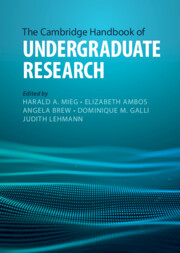Book contents
- The Cambridge Handbook of Undergraduate Research
- The Cambridge Handbook of Undergraduate Research
- Copyright page
- Contents
- Figures
- Tables
- Contributors
- Foreword
- Foreword
- 1 Introduction
- Part I Theory and Research on Undergraduate Research
- Part II Implementation, Approaches, Methods
- Part III Disciplines
- Part IV International Perspective
- 47 Introduction
- Part IV.1 Americas
- Part IV.2 Africa & Middle East
- Part IV.3 Asia & Oceania
- Part IV.4 Europe
- 64 Undergraduate Research in Austria
- 65 Undergraduate Research in France
- 66 Undergraduate Research in Germany
- 67 Undergraduate Research in Italy
- 68 Undergraduate Research in the Netherlands
- 69 Undergraduate Research in Portugal
- 70 Undergraduate Research in Russia
- 71 Undergraduate Research in Scandinavia
- 72 Undergraduate Research in the UK
- Part V Avenues for Developing Undergraduate Research
- Index
- References
71 - Undergraduate Research in Scandinavia
Focusing on Students as Researchers
from Part IV.4 - Europe
Published online by Cambridge University Press: 11 August 2022
- The Cambridge Handbook of Undergraduate Research
- The Cambridge Handbook of Undergraduate Research
- Copyright page
- Contents
- Figures
- Tables
- Contributors
- Foreword
- Foreword
- 1 Introduction
- Part I Theory and Research on Undergraduate Research
- Part II Implementation, Approaches, Methods
- Part III Disciplines
- Part IV International Perspective
- 47 Introduction
- Part IV.1 Americas
- Part IV.2 Africa & Middle East
- Part IV.3 Asia & Oceania
- Part IV.4 Europe
- 64 Undergraduate Research in Austria
- 65 Undergraduate Research in France
- 66 Undergraduate Research in Germany
- 67 Undergraduate Research in Italy
- 68 Undergraduate Research in the Netherlands
- 69 Undergraduate Research in Portugal
- 70 Undergraduate Research in Russia
- 71 Undergraduate Research in Scandinavia
- 72 Undergraduate Research in the UK
- Part V Avenues for Developing Undergraduate Research
- Index
- References
Summary
This chapter takes stock of current research concerning undergraduate research in Scandinavia. A literature search identified relatively few studies that explicitly employ this concept. There is a strong emphasis on “research-based education” as a principle in all three Scandinavian countries, with a broader view on linking research and education. In recent years, perspectives emphasizing inquiry, student-centeredness and problem-based learning have attracted considerable attention. There are also other indications of practices associated with students behaving as researchers – e.g., the relatively wide use of the bachelors’ thesis and specific examples of institutions and cases where principles from undergraduate research have been employed. More recent developments include theuse of honours programmes.
Keywords
- Type
- Chapter
- Information
- The Cambridge Handbook of Undergraduate Research , pp. 638 - 648Publisher: Cambridge University PressPrint publication year: 2022



